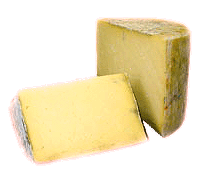





 |
|
 Though
there is a town called Cheddar in
England,
the cheese is named for one of the steps involved in the cheese-making
process conceived in the
county
of
Somerset
in southwestern
England.
After cow's-milk
curd is twice scalded, it is "cheddared" by repeatedly being cut and piled
in order to remove the whey or liquid and to break the curd until
it's smooth and silky.
The curd is salted and, in the case of traditional cheddar, transferred to
a drum as high as 16 inches, weighing up to 66 pounds. Though
there is a town called Cheddar in
England,
the cheese is named for one of the steps involved in the cheese-making
process conceived in the
county
of
Somerset
in southwestern
England.
After cow's-milk
curd is twice scalded, it is "cheddared" by repeatedly being cut and piled
in order to remove the whey or liquid and to break the curd until
it's smooth and silky.
The curd is salted and, in the case of traditional cheddar, transferred to
a drum as high as 16 inches, weighing up to 66 pounds.
In some areas where the
cheese is made by hand in small batches it is wrapped in cloth so it
can "breathe" while
aging and ripening. Most other cheddars are wrapped in plastic or wax,
which prevents the cheese from aging further. After aging 12 to 24 months,
the cheese emerges like a beautifully rustic cylinder with a tight brown,
gray, and black speckled cloth rind. (Sometimes cheddars age as long as 3
years, or more. These cheeses are usually past their prime though they
might offer interesting nuances like a good wine beyond its peak.)
There are no
government regulations in the
United States
for farmhouse cheddar.
| |
Milk Used |
Aging Period |
Color |
Texture |
Flavor |
Purchase Unit |
|
English Cheddar Cheese |
Cow's Milk |
3 to 12 months |
Yellow or white |
Hard |
Sharp |
11/14 lb. cheddar, 1/2- and 3-lb. packages |
[ Alentejo ] [ Allgau Emmentaller ] [ Apple Cheese ] [ Asiago ] [ Cheshire Cheese ] [ English Cheddar ] [ Gammelost ] [ Gruyere Cheese ] [ Hard Cheese ] [ Parmesan ] [ Pineapple Cheese ] [ Romano Cheese ] [ Sap Sago Cheese ]

|
 Though
there is a town called Cheddar in
Though
there is a town called Cheddar in
